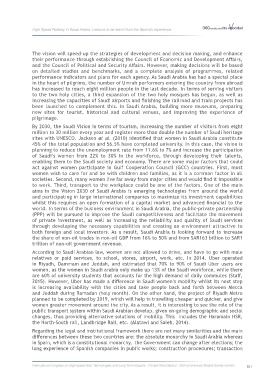Page 523 - 360.revista de Alta Velocidad - Nº 6
P. 523
High Speed Railway in Saudi Arabia: Lessons to be learnt from the Spanish experience
The vision will speed–up the strategies of development and decision making, and enhance
their performance through establishing the Council of Economic and Development Affairs,
and the Council of Political and Security Affairs. However, making decisions will be based
on detailed studies and benchmarks, and a complete analysis of programmes, related
performance indicators and plans for each agency. As Saudi Arabia has had a special place
in the heart of pilgrims, the number of Umrah performers entering the country from abroad
has increased to reach eight million people in the last decade. In terms of serving visitors
to the two holy cities, a third expansion of the two holy mosques has begun, as well as
increasing the capacities of Saudi airports and finishing the railroad and train projects has
been launched to complement this. In Saudi Arabia, building more museums, preparing
new sites for tourist, historical and cultural venues, and improving the experience of
pilgrimage.
By 2030, the Saudi Vision in terms of tourism, increasing the number of visitors from eight
million to 30 million every year and register more than double the number of Saudi heritage
sites with UNESCO. Jackson et al. (2010) identified that women in Saudi Arabia constitute
45% of the total population and 56.5% have completed university. In this case, the vision is
planning to reduce the unemployment rate from 11.6% to 7% and increase the participation
of Saudi’s women from 22% to 30% in the workforce, through developing their talents,
enabling them to the Saudi society and economy. There are some major factors that could
act against women participate in Gulf Cooperation Council (GCC) countries. First, most
women wish to care for and be with children and families, as it is a common factor in all
societies. Second, many women live far away from major cities and would find it impossible
to work. Third, transport to the workplace could be one of the factors. One of the main
aims in the Vision 2030 of Saudi Arabia is emerging technologies from around the world
and participating in large international companies to maximize its investment capabilities
whilst this requires an open formation of a capital market and advanced financial to the
world. In terms of the business environment in Saudi Arabia, the public-private partnership
(PPP) will be pursued to improve the Saudi competitiveness and facilitate the movement
of private investment, as well as increasing the reliability and quality of Saudi services
through developing the necessary capabilities and creating an environment attractive to
both foreign and local investors. As a result, Saudi Arabia is looking forward to increase
the share of non-oil trades in non-oil GDP from 16% to 50% and from SAR163 billion to SAR1
trillion of non-oil government revenue.
According to Saudi Arabian law, women are not allowed to drive, and have to go with male
relatives or paid services, to school, stores, airport, work, etc. In 2014, Uber operated
in Riyadh, Dammam and Jeddah, and estimated that 70% to 90% of Saudi Uber users are
women, as the women in Saudi arabia only make up 13% of the Saudi workforce, while there
are 60% of university students that accounts for the high demand of daily commutes (Staff,
2015). However, Uber has made a difference in Saudi women’s mobility whilst its next step
is increasing availability with the cities and take people back and forth between Mecca
and Jeddah during Ramadan (holy month). On the other hand, the project of Riyadh Metro
planned to be completed by 2019, which will help in travelling cheaper and quicker, and give
women greater movement around the city. As a result, it is interesting to see the role of the
public transport system within Saudi Arabian develop, given on-going demographic and social
changes, thus providing alternative solutions of mobility. This includes the Haramain HSR,
the North-South rail, Landbridge Rail, etc. (Alatawi and Saleh, 2014).
Regarding the legal and institutional framework there are not many similarities and the main
differences between these two countries are: the absolute monarchy in Saudi Arabia whereas
in Spain, which is a constitutional monarchy, the Government can change after elections; the
long experience of Spanish companies in public works; construction procedures; transaction
International Congress on High-speed Rail: Technologies and Long Term Impacts - Ciudad Real (Spain) - 25th anniversary Madrid-Sevilla corridor 521

